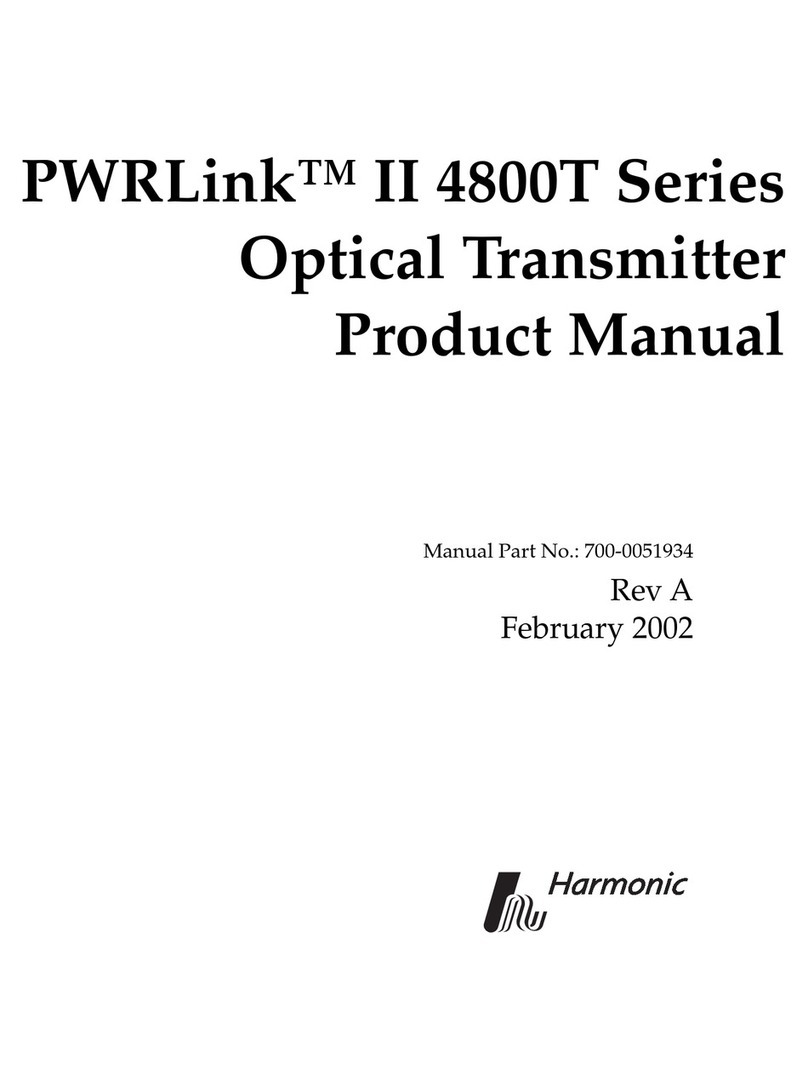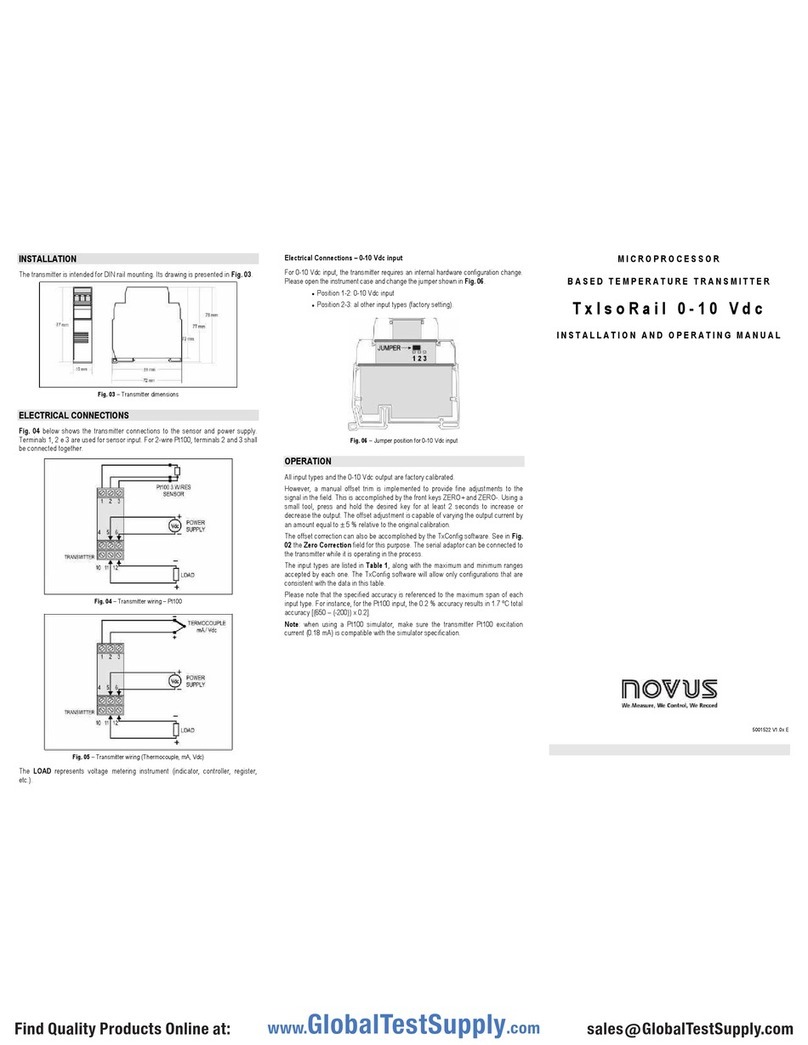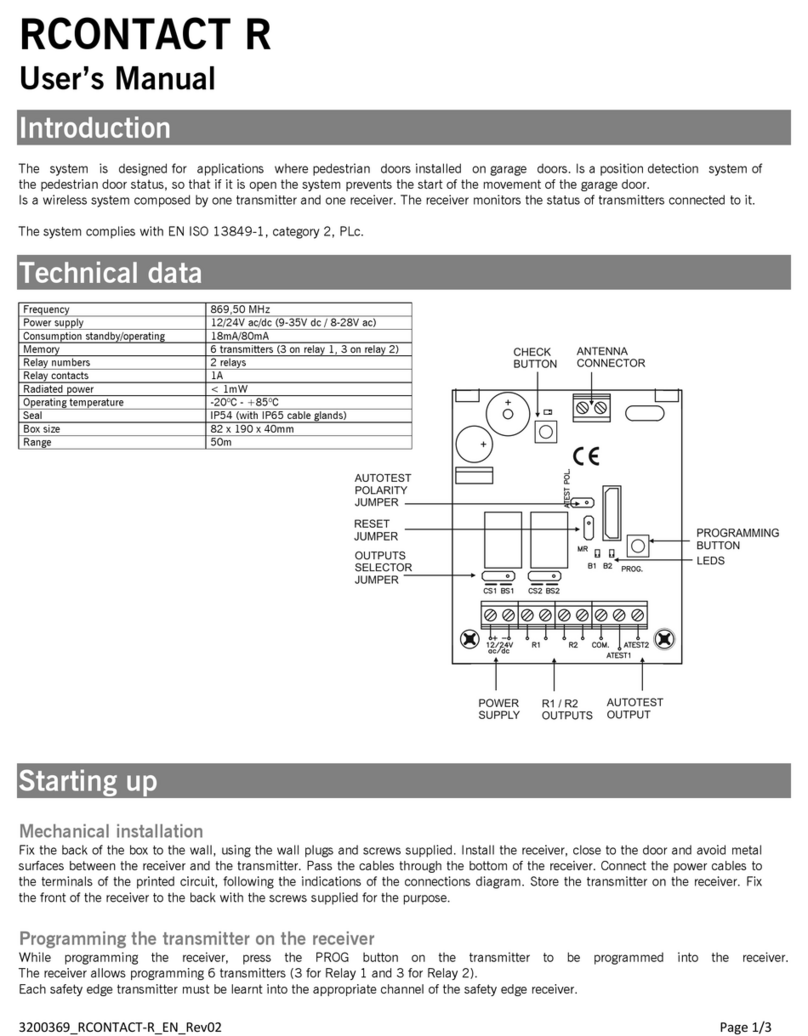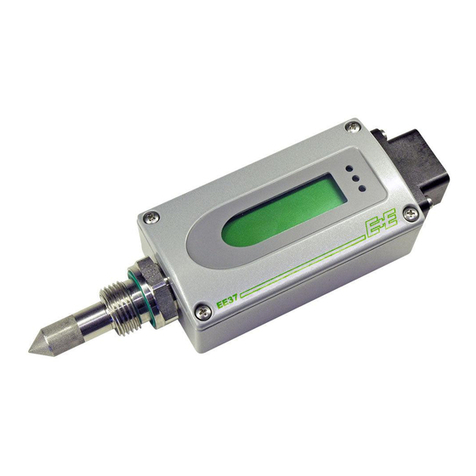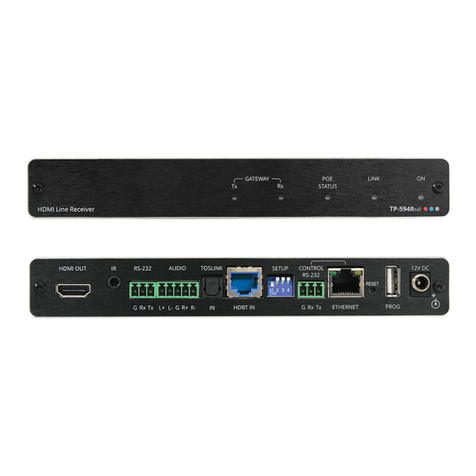Harmonic SUPRALink 7110-E Series User manual

SUPRALink™ 7110-Exx
Optical Transmitter
Installation Guide
Rev A
Manual Part No. 700-0052027

© 2009 Harmonic Inc. All rights reserved.
Disclaimer
Harmonic reserves the right to alter the equipment specifications and descriptions in this publication without prior notice. No part of
this publication shall be deemed to be part of any contract or warranty unless specifically incorporated by reference into such
contract or warranty. The information contained herein is merely descriptive in nature, and does not constitute a binding offer for
sale of the product described herein. Harmonic assumes no responsibility or liability arising from the use of the products described
herein, except as expressly agreed to in writing by Harmonic. The use and purchase of this product do not convey a license under
any patent rights, copyrights, trademark rights, or any intellectual property rights of Harmonic. Nothing hereunder constitutes a
representation or warranty that using any products in the manner described herein will not infringe any patents of third parties.
Trademark Acknowledgments
Harmonic and all Harmonic product names are trademarks of Harmonic Inc. All other trademarks are the property of their respective
owners.
Compliance and Approval
This equipment has been tested and found to comply with the limits for a Class A digital device, pursuant to Part 15, Subpart B of the
Federal Communications Commission (FCC) rules.
These limits are designed to provide reasonable protection against harmful interference when the equipment is operated in a
commercial environment.
This equipment generates, uses, and can radiate radio frequency energy. It may cause harmful interference to radio communications
if it is not installed and used in accordance with the instructions in this manual. Operation of this equipment in a residential area is
likely to cause harmful interference. If this occurs, the user will be required to correct the interference at his or her own expense.
This device complies with Part 15 of the FCC rules. Operation is subject to the following two conditions: (1) this device may not
cause harmful interference, and (2) this device must accept any interference received, including interference that may cause
undesired operation.
Connections between the Harmonic equipment and other equipment must be made in a manner that is consistent with maintaining
compliance with FCC radio frequency emission limits. Modifications to this equipment not expressly approved by Harmonic may
void the authority granted to the user by the FCC to operate this equipment.
WEEE/RoHS Compliance Policy
Harmonic Inc. intends to comply fully with the European Union’s Directive 2002/96/EC as amended by Directive 2003/108/EC, on
Waste Electrical and Electronic Equipment, also known as “WEEE,” and Directive 2002/95/EC, as amended, on the Restriction of
use of Hazardous Substances, also known as “RoHS.”
Harmonic will ensure that product which cannot be reused will be recycled in compliance with the WEEE Directive. To that end,
users are advised that (1) Harmonic equipment is not to be discarded in household or office garbage, (2) Harmonic Inc. will pay the
freight for shipment of equipment to be disposed of if it is returned to Harmonic, (3) customers should call the normal RMA
telephone numbers to arrange for such shipment, and (4) for additional and updated information on this process customers may
consult the Harmonic website: http://harmonicinc.com/ah_weee_recycle.cfm.
Harmonic will ensure that its products will be either reused or recycled in compliance with the WEEE Directive. For the latest
information concerning Harmonic’s WEEE/RoHS Compliance Policy and its Recycling and Take-Back process, please visit our web
site.

© 2009 Harmonic Inc. All rights reserved.
产品中的有毒有害物质或元素的名称及含量表
Names and Contents of the Toxic and Hazardous Substances or Elements in the
Products if the Part is Present
该表显示哈雷公司产品中可能含有的有毒有害物质元配件的信息,除了来源于元配件供应商的物料成分资料,
亦来自其它相关的机构与资料。哈雷产品不一定使用这些元配件。
This table shows those components where hazardous substances may be found in Harmonic products based on, among other
things, material content information provided by third party suppliers. These components may or may not be part of the product.
除非特殊注明,哈雷公司产品的环保使用期限 均为 20 年。该环保使用期限的有效条件为:必须遵循该产品使
用手册的规定,对该产品进行使用或存储。
The Environmental Protective Use Period for Harmonic products is 20 years unless displayed otherwise on the product. The EPUP
period is valid only when the products are operated or stored as per the conditions specified in the product manual.
O: 表示在该部件的所有均质材料中,此类有毒有害物质的含量均小于 SJ/T11363-2006 标准所规定的限量。
O: Indicates the content of the toxic and hazardous substances at the homogeneous material level of the parts is below the limit
defined in SJ/T11363 2006 standard.
X: 表示至少在该部件的某一均质材料中,此类有毒有害物质的含量超出 SJ/T11363-2006 标准规定的限量。
X: Indicates that the content of the toxic and hazardous substances in at least one of the homogeneous materials of the parts is
above the limit defined in SJ/T11363 2006 standard.
部件名称 (Part name) 有毒有害物质或元素 (Hazardous Substance)
铅
(PB) 汞
(Hg) 镉
(Cd) 六价铬
(CrVI) 多溴联苯
(PBB) 多溴二苯醚
(PBDE)
印刷线路板
(Printed Circuit Assemblies)
XOO O O O
机械组件
(Mechanical Subassemblies)
XOO O O O
光学组件
(Optical Subassemblies)
XOO O O O
电源
(Power Supplies)
XOO O O O
缆线 / 线束
(Cables, harnesses)
XOO O O O
屏幕 / 显示器
(Screens, Monitors)
XOO O O O
金属零件
(Metal Parts)
OOO O O O
塑料 / 发泡材料
(Plastics, foams)
OOO O O O
电池
(Batteries)
XOO O O O

© 2009 Harmonic Inc. All rights reserved.
Standards and Agency Approval
The following tables list regulatory standards and agency approvals:
North America
Standards
EMI: FCC Part 15, Subpart B; Class AICES-003, Issue 2, Class A
Safety: UL 60950-1, CSA 60950-1, 21 CFR 1040 (CDRH)
Europe
Japan
Australia and New Zealand
Standards
EMI/EMC: EN55022, EN55024, EN 6100-3-2, EN6100-3-3
Safety: EN 60950-1, EN 60825-1
Standards
EMI: VCCI V-3 / 2007.04
Standards
EMI: AS/NZS- CISPR 22:2205

© 2009 Harmonic Inc. All rights reserved.
Documentation Conventions
This manual uses some special symbols and fonts to call your attention to important information. The
following symbols appear throughout this manual:
DANGER: The Danger symbol calls your attention to information that, if ignored, can cause physical
harm to you.
CAUTION: The Caution symbol calls your attention to information that, if ignored, can adversely affect
the performance of your Harmonic product, or that can make a procedure needlessly difficult.
LASER DANGER: The Laser symbol and the Danger alert call your attention to information about the
lasers in this product that, if ignored, can cause physical harm to you.
NOTE: The Note symbol calls your attention to additional information that you will benefit from
heeding. It may be used to call attention to an especially important piece of information you need, or it
may provide additional information that applies in only some carefully delineated circumstances.
TIP: The Tip symbol calls your attention to parenthetical information that is not necessary for performing
a given procedure, but which, if followed, might make the procedure or its subsequent steps easier,
smoother, or more efficient.
In addition to these symbols, this manual uses the following text conventions:
■Data Entry: indicates text you enter at the keyboard.
■User Interface: indicates a button to click, a menu item to select, or a key or key sequence
to press.
■Screen Output: shows console output or other text that is displayed to you on a
computer screen.
■Bold: indicates the definition of a new term.
■Italics: used for emphasis, cross-references, and hyperlinked cross-references in online
documents.

Installation Guide Rev A (6/09) 6
Table of Contents
Chapter 1 Overview
1.1 About This Manual . . . . . . . . . . . . . . . . . . . . . . . . . . . . . . . . . . . . . . . . . 8
1.2 Description. . . . . . . . . . . . . . . . . . . . . . . . . . . . . . . . . . . . . . . . . . . . . . . . 8
1.3 Applications . . . . . . . . . . . . . . . . . . . . . . . . . . . . . . . . . . . . . . . . . . . . . . 10
Chapter 2 Installing the SPL 7110-Exx Transmitter
2.1 Receiving and Inspecting . . . . . . . . . . . . . . . . . . . . . . . . . . . . . . . . . . . 13
2.2 Installing the Transmitter Module . . . . . . . . . . . . . . . . . . . . . . . . . . . . 13
2.3 Connecting the Fiber Cable . . . . . . . . . . . . . . . . . . . . . . . . . . . . . . . . . 15
2.4 Connecting the RF Broadband Input . . . . . . . . . . . . . . . . . . . . . . . . . . 15
2.5 Testing RF Signal Input . . . . . . . . . . . . . . . . . . . . . . . . . . . . . . . . . . . . . 16
Chapter 3 User Interface Options
3.1 HLP 4200 and HLP 4800 Display. . . . . . . . . . . . . . . . . . . . . . . . . . . . 17
3.1.1 Transmitter Status . . . . . . . . . . . . . . . . . . . . . . . . . . . . . . . . . . . . . . . . . 19
3.1.2 Transmitter Setup . . . . . . . . . . . . . . . . . . . . . . . . . . . . . . . . . . . . . . . . . 20
3.1.3 Transmitter Adjustments . . . . . . . . . . . . . . . . . . . . . . . . . . . . . . . . . . . 20
3.1.4 Transmitter Alarms . . . . . . . . . . . . . . . . . . . . . . . . . . . . . . . . . . . . . . . . 20
3.2 NETWatch Site Controller . . . . . . . . . . . . . . . . . . . . . . . . . . . . . . . . . . . 20
3.3 Front Panel LED Indicators . . . . . . . . . . . . . . . . . . . . . . . . . . . . . . . . . . 20
Chapter 4 Transmitter Setup
4.1 Factory-Optimized Settings. . . . . . . . . . . . . . . . . . . . . . . . . . . . . . . . . . 21
4.1.1 Returning to Factory Settings . . . . . . . . . . . . . . . . . . . . . . . . . . . . . . . 22
4.2 Fine-Tuning Each Transmitter. . . . . . . . . . . . . . . . . . . . . . . . . . . . . . . . 23
4.3 Autosetup, Automatic Gain Control, and Manual Gain Control . . . . 23
4.3.1 Autosetup . . . . . . . . . . . . . . . . . . . . . . . . . . . . . . . . . . . . . . . . . . . . . . . 23
4.3.2 Automatic Gain Control and Manual Gain Control . . . . . . . . . . . . . . 24
4.4 Setup via HLP 4200 and HLP 4800 Display . . . . . . . . . . . . . . . . . . . 24
4.4.1 Step-by-Step Setup Instructions . . . . . . . . . . . . . . . . . . . . . . . . . . . . . 24
4.4.2 Setting Fiber Length . . . . . . . . . . . . . . . . . . . . . . . . . . . . . . . . . . . . . . . 25
4.4.3 Fine-Tuning the Transmitter . . . . . . . . . . . . . . . . . . . . . . . . . . . . . . . . 25
4.4.4 Resetting the Transmitter to Factory Defaults . . . . . . . . . . . . . . . . . . 26
4.5 Setup via NETWatch Site Controller . . . . . . . . . . . . . . . . . . . . . . . . . . 26
4.6 Using the SPL 7110- Exx in a Multiwavelength Application . . . . . . . 27
Chapter 5 Maintenance
5.1 Cleaning Fiber Optic Connectors . . . . . . . . . . . . . . . . . . . . . . . . . . . . 28
5.1.1 Cleaning Patch Cord or Pigtail Fiber Optical Connectors . . . . . . . . 28
5.1.2 Cleaning Transmitter Module Optical Connectors . . . . . . . . . . . . . . 28
5.2 Fan Replacement. . . . . . . . . . . . . . . . . . . . . . . . . . . . . . . . . . . . . . . . . . 29
Chapter 6 Troubleshooting
6.1 Troubleshooting. . . . . . . . . . . . . . . . . . . . . . . . . . . . . . . . . . . . . . . . . . . 30

Table of Contents
7Installation Guide
6.2 In Case of Problems . . . . . . . . . . . . . . . . . . . . . . . . . . . . . . . . . . . . . . . 30
6.3 Disclaimer . . . . . . . . . . . . . . . . . . . . . . . . . . . . . . . . . . . . . . . . . . . . . . . 30
6.4 Contacting Harmonic Support . . . . . . . . . . . . . . . . . . . . . . . . . . . . . . . 31
Appendix A Technical Specifications
A.1 Optical Output . . . . . . . . . . . . . . . . . . . . . . . . . . . . . . . . . . . . . . . . . . . 32
A.2 Optical Power . . . . . . . . . . . . . . . . . . . . . . . . . . . . . . . . . . . . . . . . . . . . 32
A.3 RF Input . . . . . . . . . . . . . . . . . . . . . . . . . . . . . . . . . . . . . . . . . . . . . . . . . 32
A.4 User Interface . . . . . . . . . . . . . . . . . . . . . . . . . . . . . . . . . . . . . . . . . . . . 32
A.5 Power Requirements . . . . . . . . . . . . . . . . . . . . . . . . . . . . . . . . . . . . . . 33
A.6 Environmental . . . . . . . . . . . . . . . . . . . . . . . . . . . . . . . . . . . . . . . . . . . . 33
A.7 Physical . . . . . . . . . . . . . . . . . . . . . . . . . . . . . . . . . . . . . . . . . . . . . . . . . 33
A.8 Models Available . . . . . . . . . . . . . . . . . . . . . . . . . . . . . . . . . . . . . . . . . 33
A.9 Laser Radiation Warning . . . . . . . . . . . . . . . . . . . . . . . . . . . . . . . . . . . 34
A.10 Compliance with WEEE . . . . . . . . . . . . . . . . . . . . . . . . . . . . . . . . . . . . 35
Appendix B HLP 4200 and HLP4800 Menu Display

© 2009 Harmonic Inc. 8 SPL 7110-Exx, Version 1.0, Rev A
Chapter 1
Overview
1.1 About This Manual
This instruction manual is a complete guide to installation, configuration and operation of the
SUPRALink SPL 7110-Exx. The models that are covered by this manual are listed in Appendix
A, Section A.8.
■Chapter 1, Overview provides a description of the SPL 7110-Exx.
■Chapter 2, Installing the SPL 7110-Exx Transmitter describes the installation procedure.
■Chapter 3, User Interface Options introduces the user interfaces.
■Chapter 4, Transmitter Setup describes how to set up and configure the transmitter.
■Chapter 5, Maintenance outlines maintenance procedures.
■Chapter 6, Troubleshooting provides instructions on what to do in the event of problems.
■Appendix A, Technical Specifications provides complete technical specifications.
■Appendix B, HLP 4200 and HLP4800 Menu Display shows additional user interface
details.
1.2 Description
The SPL 7110-Exx transmitter is a compact plug-in module designed for use in the Harmonic
HLP 4200 and 4800 equipment platform. An HMC 4001 module carrier is needed to mount
the transmitter in the platform. Harmonic has optimized the SUPRALink family of transmitter
modules for high-performance transmission of RF broadband information over optical fiber
networks.
The SPL 7110-Exx has the following key features:
■Selection of eight DWDM wavelengths
■Transmission bandwidth from 50 to 1003 MHz
■Electronic dispersion compensation for high channel loads with minimal fiber-induced,
second-order distortion
■Compensation up to 40 km, with up to 950 MHz total RF load
■SPL7110S-EXX is optimized for NTSC channel loading: 78 NTSC (System M) analog
channels plus 75 channels of QAM256 digital loading
■SPL7110C-EXX is optimized for Cenelec channel loading: 41 Cenelec analog channels
plus 56 channels of QAM256 digital loading
■Internal monitoring and control using 32-bit microprocessor
■Local control of operating parameters—provided by the HLP 4200 and 4800 platform
■Remote control and monitoring—provided by NETWatch Site Controller
■Autosetup feature that adjusts RF pad for optimum modulation performance
■Automatic gain control and manual gain control modes of operation
Figure 1-1 shows front and rear panel features of the SPL 7110-Exx transmitter module.

Status LED: Bi-state LED
illuminates green when the
module is functioning properly,
or red during alarm or power up
Select LED: Yellow-colored LED
illuminates when the module is
selected through the front panel
Download
Connector
RF Monitor:
Monitor point
for RF signal
at the transmitter
RF In: Female F
connector
Optical Out
Chapter 1 Overview Description
© 2009 Harmonic Inc. 9 SPL 7110-Exx, Version 1.0, Rev A
Figure 1-1: SPL 7110-Exx front and rear panel features
Transmitter performance is optimized by combining state-of-the-art 1550 DWDM distributed
feedback (DFB) laser technology and patent pending, pre-distortion linearization circuitry.
Harmonic has designed the SUPRALink family for integration into networks with advanced
element management systems; each transmitter module employs a microprocessor-based
communication and monitoring architecture. Figure 1-2 is a block diagram of the SPL 7110-
Exx transmitter.
The transmitter’s microprocessor continuously monitors and controls all critical transmitter
parameters in order to optimize performance over both time and temperature changes. The
microprocessor-controlled parameters include:
■Input signal attenuation pad
■Laser power, temperature, and bias
■Electrical circuit temperature and setpoints

Chapter 1 Overview Applications
© 2009 Harmonic Inc. 10 SPL 7110-Exx, Version 1.0, Rev A
Figure 1-2: SPL 7110-Exx block diagram
The SPL 7110-Exx transmitter is a compact plug-in module that mounts easily in Harmonic’s
HLP 4200 and HLP 4800 platform via the HMC 4001 module carrier.
For additional information on the HLP 4200 platform and HLP 4800 platform and its
associated communication and power buses, see the HLP 4200 Instruction Manual or the
HLP 4800 Users’s Guide.
1.3 Applications
The SPL 7110-Exx transmitter is designed to operate in multi-wavelength systems allowing
fiber conservation or reclamation. The 1550nm DWDM optical signal transmitted by a
SUPRALink DWDM module must be combined and separated using Harmonic passive
multiplexor and demultiplexor optical modules. A complete family of passive optical products
is available for network design.
Figure 1-3 and Figure 1-4 show two typical applications of the SPL 7110-Exx. Broadcast
signals and QAM signals from a cable modem termination system (CMTS), cable telephony, or
video-on-demand server are combined and used to drive the SPL 7110-Exx. The optical
outputs from multiple SPL 7110-Exx are combined into a single fiber using a dense
wavelength division multiplexor (DWDM).

Chapter 1 Overview Applications
© 2009 Harmonic Inc. 11 SPL 7110-Exx, Version 1.0, Rev A
Figure 1-3: Application Example 1
In both applications, the combined optical wavelengths are transported to the hub, where
they are demultiplexed and fed into multiple nodes. In Figure 1-3, the return path signal is
carried on a separate fiber (not shown) from the forward path signal. In Figure 1-4, the return
signal is carried on the same fiber as the forward path signal.
Figure 1-4: Application Example 2

Chapter 1 Overview Applications
© 2009 Harmonic Inc. 12 SPL 7110-Exx, Version 1.0, Rev A
In multiwavelength applications, the launch power into the fiber and the total fiber distance
may need to be limited and the analog content on each wavelength must be identical to
avoid detrimental non-linear fiber optic effects. Consult your Harmonic applications engineer
for more details.

© 2009 Harmonic Inc. 13 SPL 7110-Exx, Version 1.0, Rev A
Chapter 2
Installing the SPL 7110-Exx Transmitter
This chapter describes how to:
■Receive and inspect the SUPRALink 7110-EXX Series
■Install the transmitter module in the HLP 4200 and HLP 4800 platform
■Connect the fiber cable
■Connect the RF broadband input
■Tes t R F signa l i npu t
2.1 Receiving and Inspecting
As you unpack your unit, inspect the shipping container and equipment for damage. Save the
shipping material for future use.
If the container or the equipment is damaged, notify both the freight carrier and Harmonic.
(see Contacting Harmonic Support on page 31 for contact information).
CAUTION: Before removing equipment from its antistatic bag, touch a ground point for several seconds.
A suitable ground point is an unpainted part of the chassis of a grounded piece of equipment.
2.2 Installing the Transmitter Module
CAUTION: To protect yourself from potential injury and to protect the equipment from further damage,
do not perform any operational tests if the equipment appears to be damaged.
The SPL 7110-Exx transmitter module plugs into the HMC 4001 module carrier, shown in
Figure 2-1 on page 14 . The transmitter module is held in the carrier by a spring-loaded tab on
the front handle of the carrier. You can place the HMC 4001 carrier into any desired position
in the HLP 4200 and HLP 4800 platform.
The SPL 7110-Exx module can be plugged into the carrier either with the carrier already
mounted in the HLP 4200 and HLP 4800 platform, or prior to mounting the carrier into the
platform. The HLP 4200 and HLP 4800 platform can be powered and operational during the
plug-in process.

Figure 2-1: HMC 4001 module carrier front and rear panel features
Chapter 2 Installing the SPL 7110-Exx Transmitter Installing the Transmitter Module
© 2009 Harmonic Inc. 14 SPL 7110-Exx, Version 1.0, Rev A
To install the transmitter module in the HMC 4001 carrier:
■Insert the transmitter into the carrier until it locks into position.
To remove the transmitter module from the HMC 4001 carrier:
■Press down the spring-loaded tab on the carrier, then pull out the module.
To install the HMC 4001 carrier in the HLP 4200 and HLP 4800 platform:
1. Lower the HLP 4200 platform’s control/display panel.
2. Slide the HMC 4001 carrier into any available slot in the platform until it is properly
seated.
3. Lock the carrier into position with the carrier locking screw, shown in Figure 2-1.
The SPL 7110-Exx receives power from the HMC 4001 carrier. The carrier is powered by the
+24 VDC bus of the HLP 4200 and HLP 4800.
For additional information on the HLP 4200 platform and HLP 4800 platform and its
associated communication and power buses, see the HLP 4200 Instruction Manual or the
HLP 4800 User’s Guide.

Chapter 2 Installing the SPL 7110-Exx Transmitter Connecting the Fiber Cable
© 2009 Harmonic Inc. 15 SPL 7110-Exx, Version 1.0, Rev A
2.3 Connecting the Fiber Cable
To proceed with installation, connect the fiber optic cable to the transmitter output. The
optical output connector of the SPL 7110-Exx is located on the rear of the module, as shown
in Figure 1-1 on page 9.
DANGER: Invisible Laser Radiation. AVOID EXPOSURE TO BEAM. Never operate unit with a broken fiber
or with a fiber connector disconnected.
To connect fiber optic cable to the transmitter output:
1. Verify that the transmitter module has been mounted into the HLP platform, as described
in Section 2.2..
2. Determine the connector type on the SPL 7110-Exx. The standard optical connector
recommended by Harmonic is SC/APC. Other connector types can be special ordered.
3. Verify that the type of connector on the fiber cable is the same as what is on the SPL
7110-Exx, for example, SC/APC.
4. Verify that the fiber cable connector has been cleaned properly. If the fiber cable
connector needs to be cleaned, follow the cleaning procedure outlined in Section
5.1.1 Cleaning Patch Cord or Pigtail Fiber Optical Connectors on page 28.
5. Verify that the SUPRALink optical connector has not been exposed to any contamination.
If you suspect that the connector may have been exposed to contamination (for example,
by a dirty fiber cable connector), follow the cleaning procedure outlined in Section
5.1.2 Cleaning Transmitter Module Optical Connectors on page 28.
NOTE: Any contamination of either the fiber cable or SPL 7110-Exx connector can significantly degrade
optical link performance. This degradation will most likely manifest itself as poor carrier-to-noise (CNR)
performance.
6. For SC-type optical connectors, note the key characteristics of the mating connectors and
align them accordingly. Gently insert the fiber cable connector into that of the SPL 7110-
Exx until the connector clicks into place.
For FC-type optical connectors, note the key characteristics of the mating connectors and
align them accordingly. Gently insert the fiber cable connector into that of the SPL 7110-
Exx and tighten the rotating sleeve of the connector. Do not overtighten!
2.4 Connecting the RF Broadband Input
The SPL 7110-Exx broadband RF connector is located on the rear panel of the module, as
shown in Figure 1-1 on page 9.
The SPL 7110-Exx female F connector accepts a 75 ohm impedance coaxial cable
terminated with a male F-type connector. The male F connector on the cable should have a
center pin diameter in the range of 0.64 mm to 0.8 mm.
NOTE: To ensure performance integrity, use RG-59 coaxial cable. Use of a connector with a center pin
diameter greater than 0.8 mm can damage the input RF connector.
Insert the signal source connector into the SPL 7110-Exx module RF input connector and
tighten securely.
For the SPL7110S-EXX, the input video signal level must be between 15 and 20 dBmV per
analog video channel based on 78 NTSC channels with 450 MHz digital QAM channels.

Chapter 2 Installing the SPL 7110-Exx Transmitter Testing RF Signal Input
© 2009 Harmonic Inc. 16 SPL 7110-Exx, Version 1.0, Rev A
For the SPL7110C-EXX, the input video signal level must be between 16 and 20 dBmV per
analog video channel based on 41 Cenelec channels with 56 digital QAM channels..
2.5 Testing RF Signal Input
Once you have connected the RF signal source, you can use the RF monitor to verify the
presence of the RF signal input to the transmitter. The RF monitor is a test connector (female
F-type) located on the front panel of the transmitter module, as shown in Figure 1-1 on
page 9. The monitor level is 20 dB below the input level to the transmitter ±1.0 dB.

© 2009 Harmonic Inc. 17 SPL 7110-Exx, Version 1.0, Rev A
Chapter 3
User Interface Options
This chapter describes:
■HLP 4200 or 4800 display
■NETWatch Site Controller
■Front panel LED indicators
Each SUPRALink 7110-Exx Series module employs a microprocessor, which makes it easy for
you to communicate with and control the transmitter. This chapter describes three options for
such communication and control. The options are:
■HLP 4200 and HLP 4800 push buttons and display
The HLP 4200 and HLP 4800 interface provides the most comprehensive means of
monitoring and controlling SPL 7110-Exx performance. The Autosetup and Reset to
Factory Settings commands are available only through this interface. For initial setup of
the transmitter, Harmonic recommends using the HLP 4200 or HLP 4800 display, if
available.
■NETWatch Site Controller Element Management System
Once installed and configured, NETWatch Site Controller provides a straightforward way
to monitor and control a network of multiple SPL 7110-Exxs, either locally or remotely.
3.1 HLP 4200 and HLP 4800 Display
The SPL 7110-Exx can be configured and monitored conveniently via the push buttons and
LCD display of the HLP 4200 and HLP 4800 equipment platform.
Figure 3-1 provides a flowchart of the commands and messages in the Main menu, which is
at the top of the HLP 4200 and HLP 4800 platform interface hierarchy. In this figure, push-
button commands are framed in ovals, and resultant display messages are framed in
rectangular boxes.
Use the Main menu to scan through platform positions and select a specific transmitter
module to monitor and control. Instructions for navigating the Main menu are provided in
Section 4.4.1 Step-by-Step Setup Instructions on page 24.2
After you navigate the HLP 4200 and HLP 4800’s Main menu and select a specific SPL 7110-
Exx module, the Transmitter menu appears. The Transmitter menu is organized into four sub-
menus:
■Transmitter Status
■Transmitter Setup
■Transmitter Adjustments
■Transmitter Alarms
These sub-menus are described below in Section 3.1.1. through Section 3.1.4..
Figure 3-1 on page 19 shows the information and controls available in the Transmitter menu.
For further details, see Appendix B, HLP 4200 and HLP4800 Menu Display, which contains a
fully detailed chart of the menu display.

Chapter 3 User Interface Options HLP 4200 and HLP 4800 Display
© 2009 Harmonic Inc. 18 SPL 7110-Exx, Version 1.0, Rev A
The status and control parameters in the Transmitter menu apply only to the specific
transmitter module that is selected. Use the HLP 4200 and HLP 4800’s ▲and ▼buttons to
scroll through the menus. Use the Enter button to make a selection. Use the Esc button to
escape any menu.
For additional information on the HLP 4200 platform and HLP 4800 platform and its
associated communication and power buses, see the HLP 4200 Instruction Manual or the
HLP 4800 User’s Guide.

Figure 3-1: HLP 4200 and HLP 4800 platform Transmitter menu display chart
Chapter 3 User Interface Options HLP 4200 and HLP 4800 Display
© 2009 Harmonic Inc. 19 SPL 7110-Exx, Version 1.0, Rev A
3.1.1 Transmitter Status
The Transmitter Status menu lets you obtain the transmitter serial number, firmware version,
and basic operating mode parameters.

Chapter 3 User Interface Options NETWatch Site Controller
© 2009 Harmonic Inc. 20 SPL 7110-Exx, Version 1.0, Rev A
3.1.2 Transmitter Setup
The Transmitter Setup menu allows you to:
■Run the Autosetup routine
■Select Manual Gain Control (MGC) or Automatic Gain Control (AGC) mode of operation
■Enter the transmission distance
3.1.3 Transmitter Adjustments
The Transmitter Adjustments menu allows you to:
■Adjust and optimize the RF pad settings
■Set the RF input low level alarm limit
■Restore all transmitter parameters to the original factory settings
3.1.4 Transmitter Alarms
The Transmitter Alarms menu displays the active alarms in the transmitter.
NOTE: If an alarm condition is triggered in a specific transmitter module, when that transmitter is
selected through the HLP 4200 and HLP 4800 interface, the display automatically jumps to the alarm
message within the Transmitter Alarms menu.
3.2 NETWatch Site Controller
Harmonic’s NETWatch Site Controller provides a complete element management system,
including a Windows™-based GUI and communications package for monitoring and
controlling a network of multiple SPL 7110-Exx transmitters either remotely or locally. For
information on installing and using this system, consult the NETWatch Site Controller
Instruction Manual.
3.3 Front Panel LED Indicators
The SPL 7110-Exx front panel includes two LEDs, as shown in Figure 1-1 on page 9.
■The Status LED illuminates red if an alarm condition exists within the transmitter, and for a
short period during power up. The Status LED illuminates green if no alarm condition
exists and the transmitter is operating normally.
■The Select LED illuminates yellow when the transmitter module is selected via the front
panel controls of the HLP 4200 and HLP 4800.
Table of contents
Other Harmonic Transmitter manuals
Popular Transmitter manuals by other brands

M-system
M-system JPA2 instruction manual
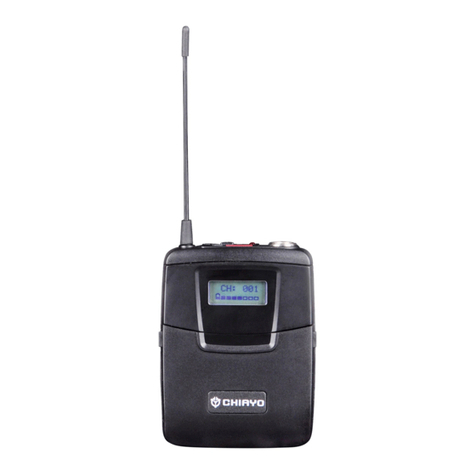
Chiayo
Chiayo SM-6100 IrDA quick start guide
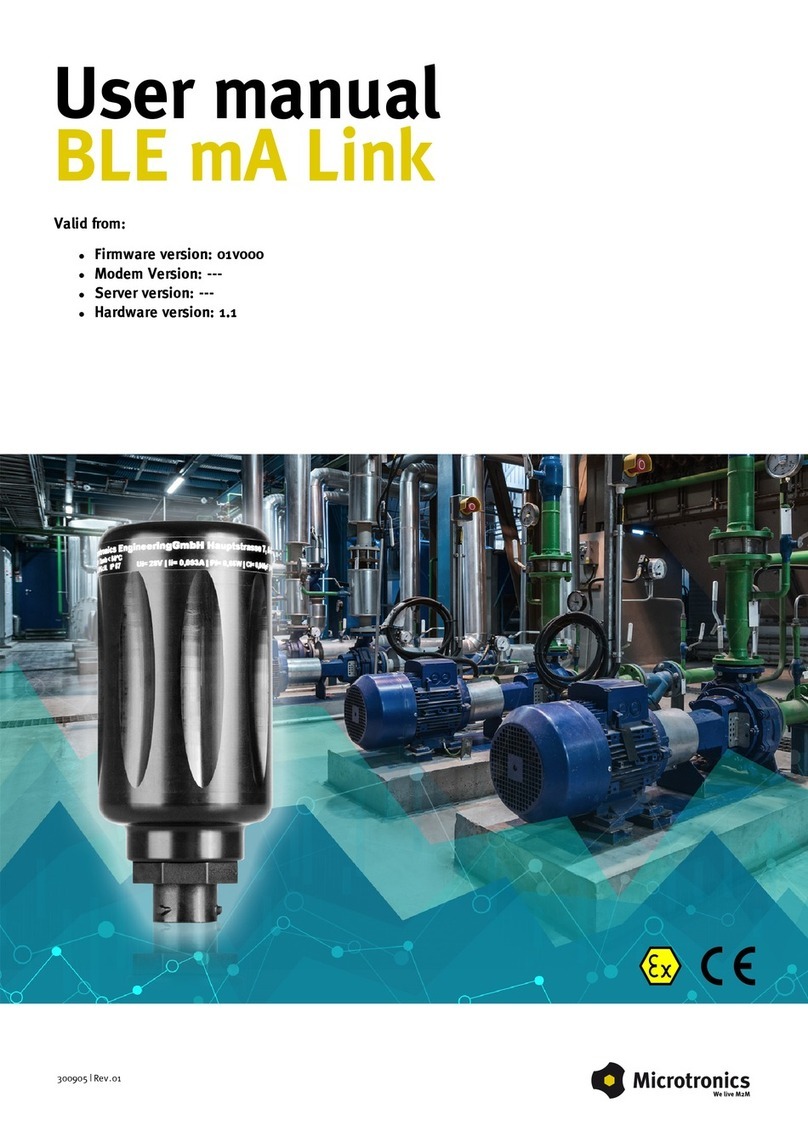
Microtronics
Microtronics BLE mA Link user manual
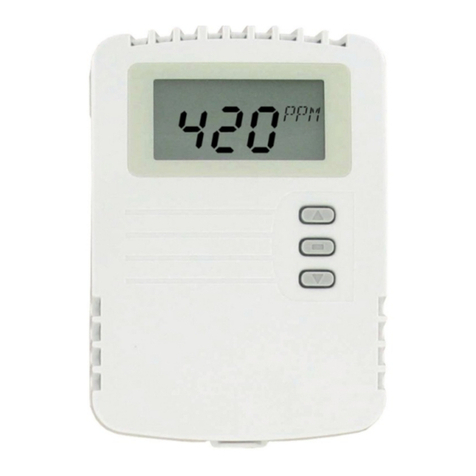
Dwyer Instruments
Dwyer Instruments CDT-2W44-LCD Installation and operating instructions

COBHAM
COBHAM C406-N Series Abbreviated component maintenance manual
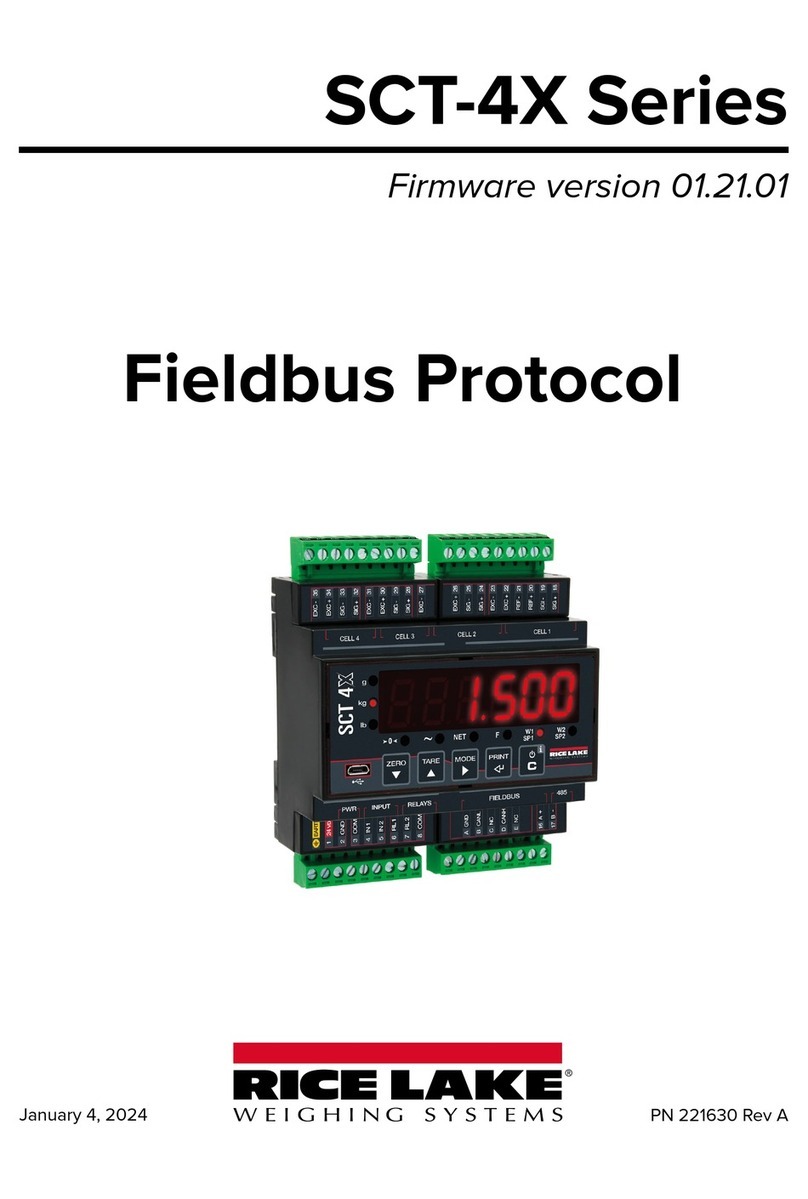
Rice Lake
Rice Lake SCT-4X Series manual
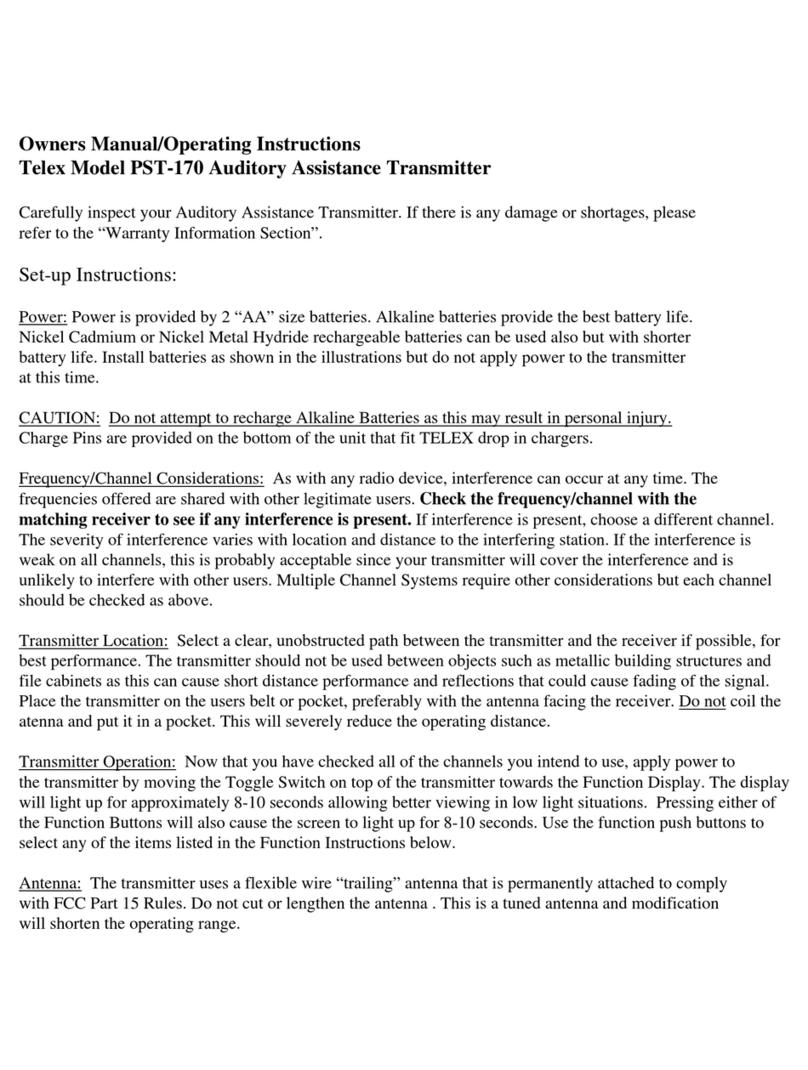
Telex
Telex PST-170 Owner's Manual and Operating Instructions
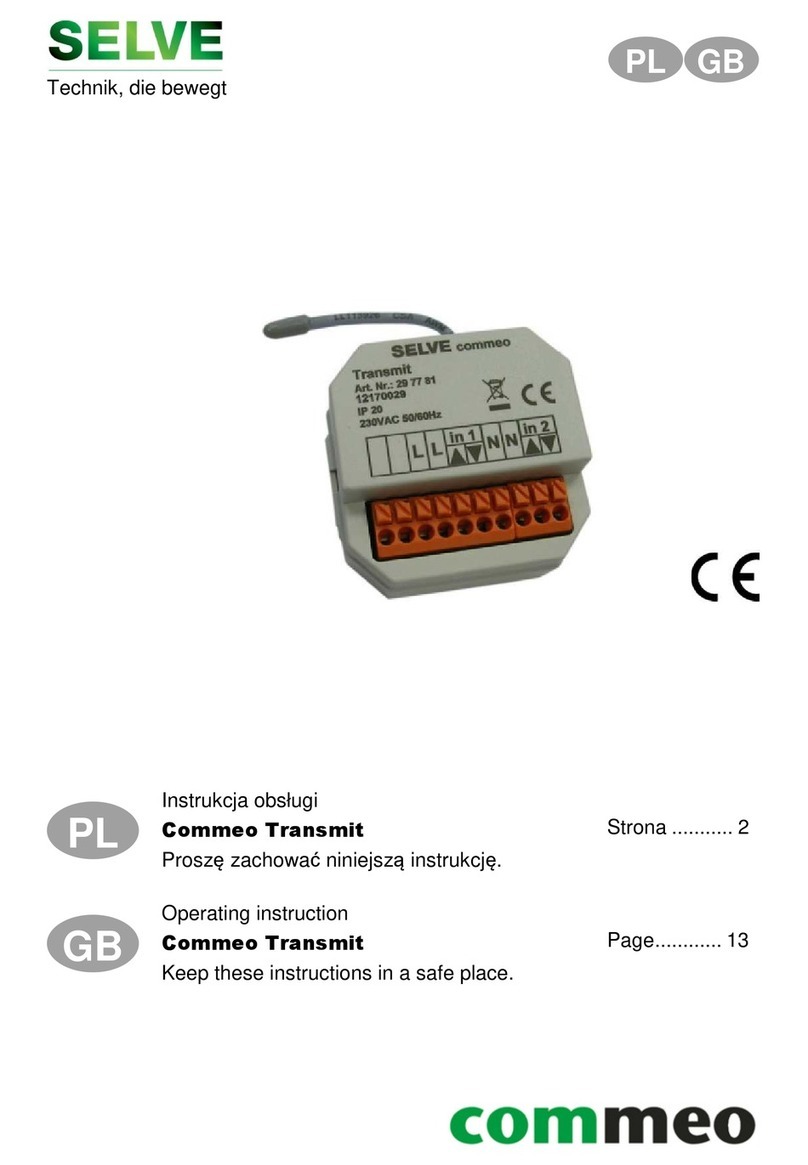
Selve
Selve Commeo Transmit Operating instruction
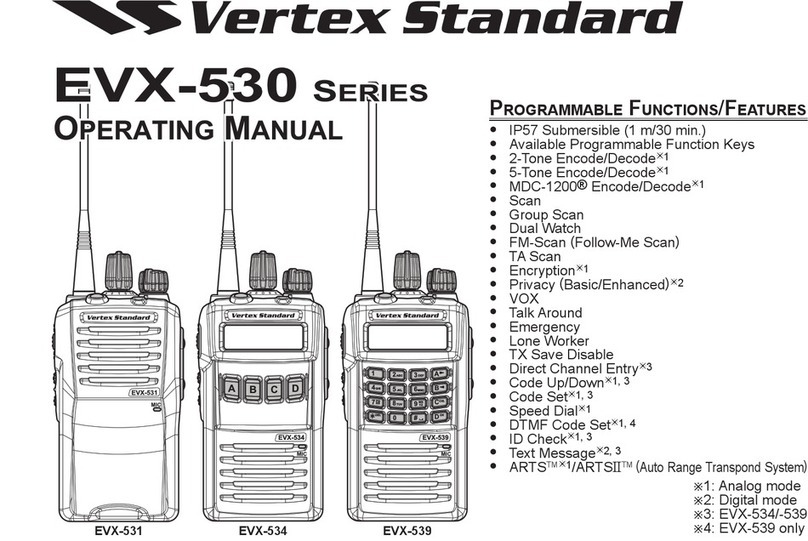
Verterx Standard
Verterx Standard EVX-530 series operating manual
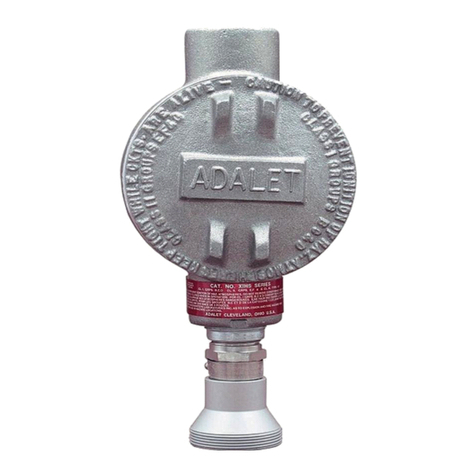
RKI Instruments
RKI Instruments 65-2394RK-CH4-4 Operator's manual
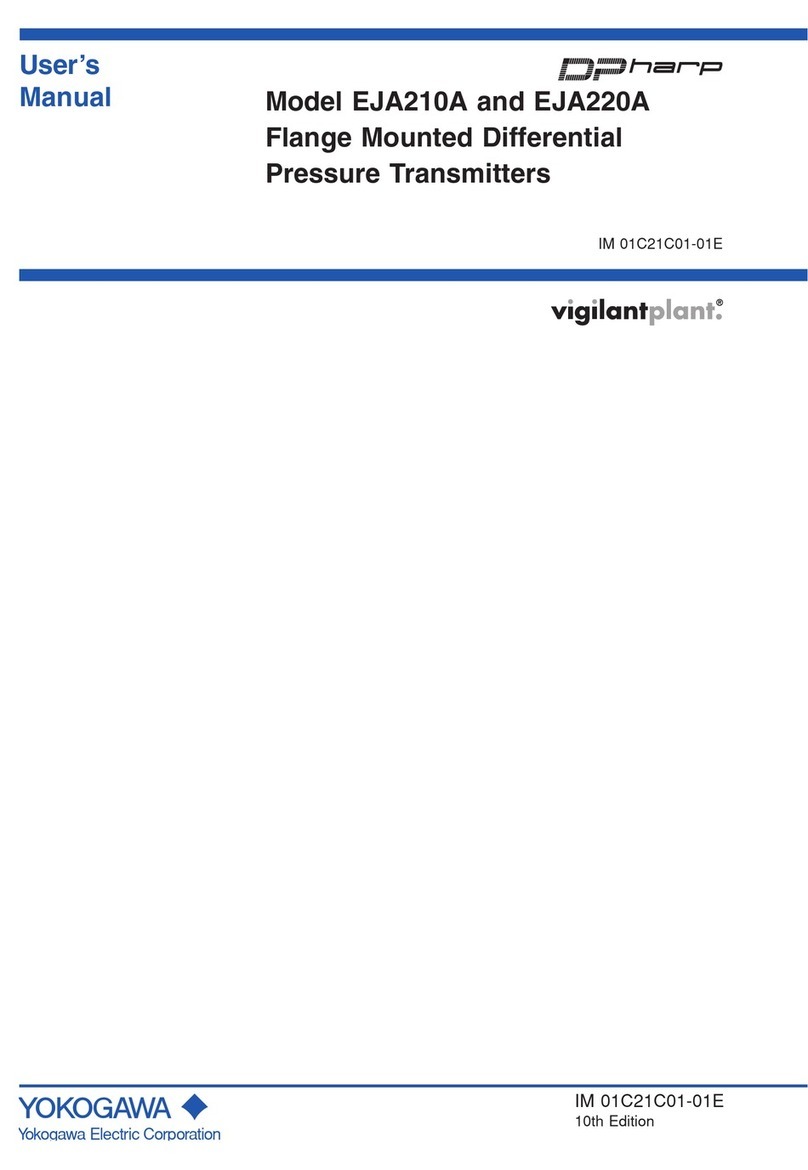
YOKOGAWA
YOKOGAWA Dpharp vigilantplant EJA210A user manual
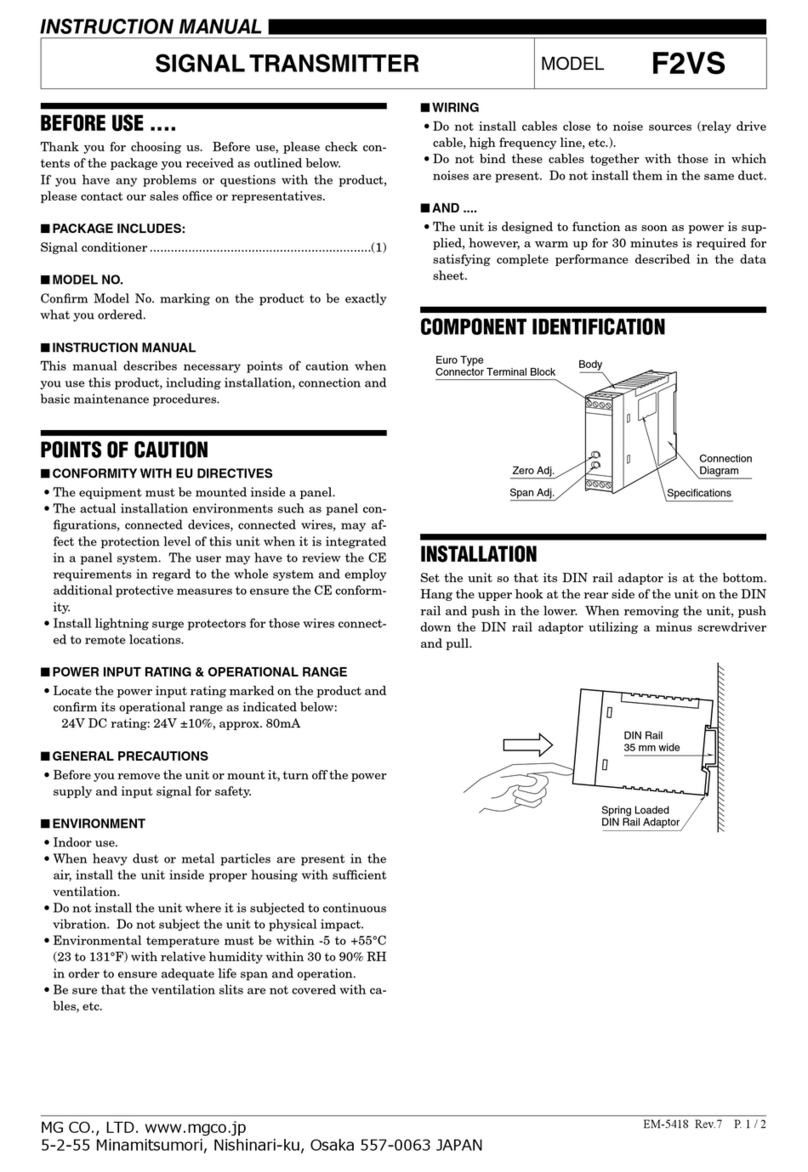
M-system
M-system F2VS instruction manual

